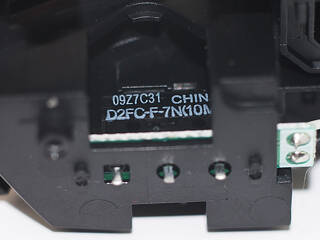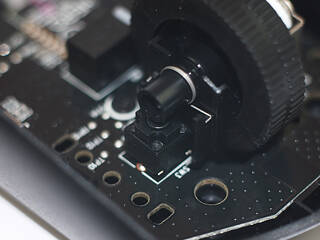 9
9
Logitech G305 Review
Sensor & Performance »Buttons, Scroll Wheel
The main buttons are light, yet crisp and tactile, which means they are very good for spamming; it is also no surprise since Logitech's spring-retention buttons work wonders. They have next to no unnecessary pre or post travel. Their clicks are very loud, however, so this mouse might be the one with the loudest main buttons I have ever tried. The switches are Omron D2FC-F-7N models, and unfortunately, they are only rated for 10 million clicks, which is a bit odd as we're talking about a mouse that costs nearly 60 bucks. Some mice I have reviewed in the past come in at half the price and feature D2FC-F-K switches that have a nominal lifespan of 50 million clicks.
As for the scroll wheel, it is nice and tactile even though scrolling through its notches is easily done. The thing I don't like about the scroll wheel is that it has a few quite sharp edges, which irritated my fingers at first. Once you get used to it, and it takes no more than a few minutes, the issue is negligible. The encoder in use is a white TTC rated for 10 million scrolls. This is thankfully a step-up from the previous wired G Pro, G102, and G203 models.
The middle click has a bit more tension than the main buttons, but is still relatively light. It has a low amount of total travel, and the switch used here is a square switch.
The side buttons are quite a letdown compared to the cheaper wired G102 and G203 models. The ones those two have are a bit mushy and a tad hard to press in, but they have next to zero unnecessary pre travel. The G305's side buttons, however, have a lot of pre travel before actuation as you really need to press them in deeply to make them click, which is especially true for the rear one. The switches are again D2FC-F-7N models manufactured by Omron. These have a nominal lifespan of 5 million actuations.
As for the CPI changer, it does the job well, is nice and light, and does not feel mushy. The clicker here shares its design with the main and side buttons, but this one is made by Kailh.
I also made a video in order to demonstrate how the buttons sound:
Mouse Feet
The stock feet are smooth and even, but have a relatively high amount of friction—you might want to replace these if you are used to pure PTFE feet of higher quality and low friction like I am. Unfortunately, the feet between the G305 and G102, G203, and G Pro are not interchangeable. The feet are not misaligned and don't scratch the mouse pad anywhere, so their general quality is still pretty nice.
Disassembling
The mouse can be disassembled after removing four screws in total, which are located beneath the mouse feet. The upper shell has two PCBs that hold the side and CPI switches. These are connected with ribbon cables, so be careful while disassembling because the ribbon cables can be torn quite easily by accident.
Jul 5th, 2025 23:11 CDT
change timezone
Latest GPU Drivers
New Forum Posts
- Help Watercooling my PC (8)
- Will you buy a RTX 5090? (627)
- RX 9000 series GPU Owners Club (1128)
- 9800x3d temps (3)
- Last game you purchased? (862)
- TPU's Rosetta Milestones and Daily Pie Thread (2375)
- What are you playing? (23897)
- Folding Pie and Milestones!! (9607)
- Do you game on a handheld console? (98)
- TPU's Nostalgic Hardware Club (20486)
Popular Reviews
- NVIDIA GeForce RTX 5050 8 GB Review
- Fractal Design Scape Review - Debut Done Right
- Crucial T710 2 TB Review - Record-Breaking Gen 5
- ASUS ROG Crosshair X870E Extreme Review
- Sapphire Radeon RX 9060 XT Pulse OC 16 GB Review - An Excellent Choice
- PowerColor ALPHYN AM10 Review
- Upcoming Hardware Launches 2025 (Updated May 2025)
- AMD Ryzen 7 9800X3D Review - The Best Gaming Processor
- Sapphire Radeon RX 9070 XT Nitro+ Review - Beating NVIDIA
- NVIDIA GeForce RTX 5060 8 GB Review
TPU on YouTube
Controversial News Posts
- Intel's Core Ultra 7 265K and 265KF CPUs Dip Below $250 (288)
- NVIDIA Grabs Market Share, AMD Loses Ground, and Intel Disappears in Latest dGPU Update (212)
- Some Intel Nova Lake CPUs Rumored to Challenge AMD's 3D V-Cache in Desktop Gaming (140)
- NVIDIA GeForce RTX 5080 SUPER Could Feature 24 GB Memory, Increased Power Limits (115)
- Microsoft Partners with AMD for Next-gen Xbox Hardware (105)
- NVIDIA Launches GeForce RTX 5050 for Desktops and Laptops, Starts at $249 (105)
- AMD Radeon RX 9070 XT Gains 9% Performance at 1440p with Latest Driver, Beats RTX 5070 Ti (102)
- Intel "Nova Lake‑S" Series: Seven SKUs, Up to 52 Cores and 150 W TDP (100)







